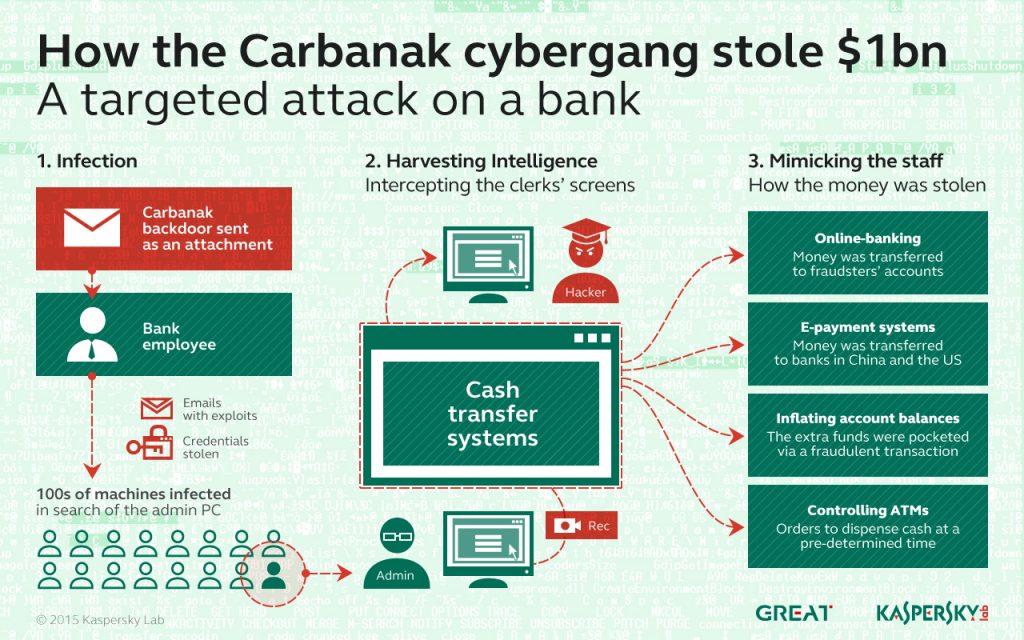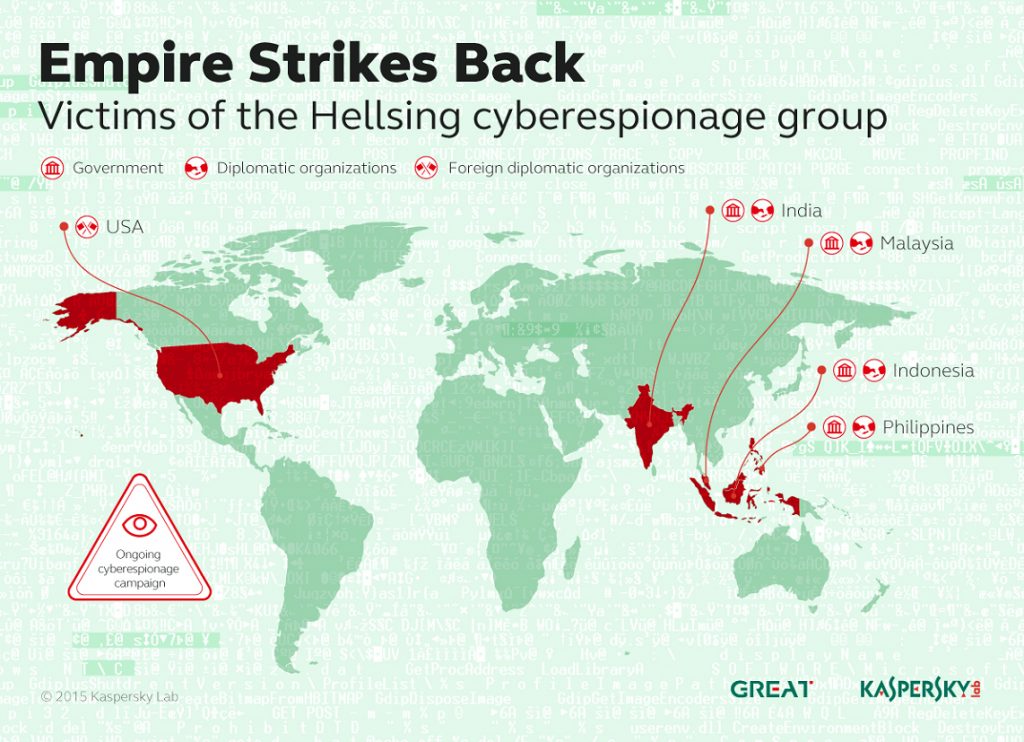
![]() Download PDF version
Download PDF version Download EPUB
Download EPUB![]() Download Full Report PDF
Download Full Report PDF Download Full Report EPUB
Download Full Report EPUB
- Top security stories
- Overall statistics for 2015
- Evolution of cyber threats in the corporate sector
- Predictions 2016
Targeted attacks and malware campaigns
Targeted attacks are now an established part of the threat landscape, so it’s no surprise to see such attacks feature in our yearly review. Last year, in our security forecast, we outlined what we saw as the likely future APT developments.
- The merger of cybercrime and APT
- Fragmentation of bigger APT groups
- Evolving malware techniques
- New methods of data exfiltration
- APT arms race
Here are the major APT campaigns that we reported this year.
Carbanak combined cybercrime – in this case, stealing money from financial institutions – with the infiltration techniques typical of a targeted attack. The campaign was uncovered in spring 2015: Kaspersky Lab was invited to conduct a forensic investigation of a bank’s systems after some of its ATMs started to dispense cash ‘randomly’. It turned out that the bank was infected. Carbanak is a backdoor designed to carry out espionage, data exfiltration and remote control of infected computers. The attackers used APT-style methods to compromise their victims – sending spear-phishing e-mails to bank employees. Once installed on a bank’s computer, the attackers carried out reconnaissance to identify systems related to processing, accounting and ATMs and simply mimicked the activities of legitimate employees. Carbanak used three methods to steal money: (1) dispensing cash from ATMs, (2) transferring money to cybercriminals using the SWIFT network and (3) creating fake accounts and using mule services to collect the money. The attackers targeted around 100 financial institutions, with total losses amounting to almost $1 billion.
One of most talked-about news stories of Q1 2015 surrounded the Equation cyber-espionage group. The attackers behind Equation successfully infected the computers of thousands of victims in Iran, Russia, Syria, Afghanistan, the United States and elsewhere – victims included government and diplomatic institutions, telecommunications companies and energy firms. This is one of the most sophisticated APT campaigns we’ve seen: one of the many modules developed by the group modifies the firmware of hard drives – providing a level of stealth and persistence beyond other targeted attacks. It’s clear that development of the code stretches back to 2001 or earlier. It’s also related to other notorious attacks, Stuxnet and Flame – for example, its arsenal included two zero-day vulnerabilities that were later to be used in Stuxnet.
While investigating an incident in the Middle East, we uncovered the activity of a previously unknown group conducting targeted attacks. Desert Falcons is the first Arabic-speaking group that has been seen conducting full-scale cyber-espionage operations – apparently connected with the political situation in the region. The first signs of this campaign date back to 2011. The first infections took place in 2013, although the peak of activity was in late 2014 and early 2015. The group has stolen over 1 million files from more than 3,000 victims. The victims include political activists and leaders, government and military organizations, mass media and financial institutions – located primarily in Palestine, Egypt, Israel and Jordan. It’s clear that members of the Desert Falcons group aren’t beginners: they developed Windows and Android malware from scratch, and skillfully organized attacks that relied on phishing e-mails, fake web sites and fake social network accounts.
#Carbanak combined stealing from financial institutions with techniques typical of a targeted attack #KLReport
Tweet
In March 2015, we published our report on the Animal Farm APT, although information on the tools used in this campaign started appearing in the previous year. In March 2014, the French newspaper, Le Monde, published an article on a cyber-espionage toolset that had been identified by Communications Security Establishment Canada (CSEC): this toolset had been used in the ‘Snowglobe’ operation that targeted French-speaking media in Canada, as well as Greece, France, Norway and some African countries. CSEC believed that the operation might have been initiated by French intelligence agencies. A year later, security researchers published analyses (<here: http://www.cyphort.com/babar-suspected-nation-state-spyware-spotlight/, here and here) of malicious programs that had much in common with ‘Snowglobe’: in particular, the research included samples with the internal name ‘Babar’ – the name of the program mentioned by CSEC. Following analysis of the malicious programs, and the connections between them, Kaspersky Lab named the group behind the attacks as Animal Farm. The group’s arsenal included two of the three zero-day vulnerabilities that we had found in 2014 and that had been used by cybercriminals: for example, an attack from the compromised web site of the Syrian Ministry of Justice using CVE-2014-0515 exploits led to the download of an Animal Farm tool called ‘Casper’. One curious feature of this campaign is that one of its programs, ‘NBOT’, is designed to conduct DDoS (Distributed Denial of Service) attacks. This is rare for APT groups. One of the malicious ‘animals’ in the farm has the strange name ‘Tafacalou’ – possibly an Occitan word (a language spoken in France and some other places).
In April 2015, we reported the appearance of a new member of a growing ‘Duke’ family that already includes MiniDuke, CosmicDuke and OnionDuke. The CozyDuke APT (also known as ‘CozyBear’, ‘CozyCat’ and ‘Office Monkeys’) targets government organisations and businesses in the United States, Germany, South Korea and Uzbekistan. The attack implements a number of sophisticated techniques, including the use of encryption, anti-detection capabilities and a well-developed set of components that are structurally similar to earlier threats within the ‘Duke’ family. However, one of its most notable features is its use of social engineering. Some of the attackers’ spear-phishing e-mails contain a link to hacked web sites – including high-profile, legitimate sites – that host a ZIP archive. This archive contains a RAR SFX that installs the malware while showing an empty PDF as a decoy. Another approach is to send out fake flash videos as e-mail attachments. A notable example (one that gives the malware one of its names) is ‘OfficeMonkeys LOL Video.zip’. When run, this drops a CozyDuke executable on to the computer, while playing a ‘fun’ decoy video showing monkeys working in an office. This encourages victims to pass the video around the office, increasing the number of compromised computers. The successful use of social engineering to trick staff into doing something that jeopardises corporate security – by CozyDuke and so many other targeted attackers – underlines the need to make staff education a core component of any business security strategy.
The Naikon APT focused on sensitive targets in south-eastern Asia and around the South China Sea. The attackers, who seem to be Chinese-speaking and have been active for at least five years, target top-level government agencies and civil and military organisations in the Philippines, Malaysia, Cambodia, Indonesia, Vietnam, Myanmar, Singapore, Nepal, Thailand, Laos and China. Like so many targeted attack campaigns, Naikon makes extensive use of social engineering to trick employees of target organizations into installing the malware. The main module is a remote administration tool that supports 48 commands designed to exercise control over infected computers: these include commands to take a complete inventory, download and upload data, install add-on modules and the use of keyloggers to obtain employees’ credentials. The attackers assigned an operator to each target country, able to take advantage of local cultural features – for example, the tendency to use personal e-mail accounts for work. They also made use of a specific proxy server within a country’s borders, to manage connections to infected computers and transfer of data to the attackers’ Command-and-Control (C2) servers. You can find our main report and follow-up report on our web site
One of the many modules developed by the #Equation group modifies the firmware of hard drives #KLReport
Tweet
While researching Naikon, we also uncovered the activities of the Hellsing APT group. This group focused mainly on government and diplomatic organisations in Asia: most victims are located in Malaysia and the Philippines, although we have also seen victims in India, Indonesia and the US. In itself, Hellsing is a small and technically unremarkable cyber-espionage group (around 20 organisations have been targeted by Hellsing). What makes it interesting is that the group found itself on the receiving end of a spear-phishing attack by the Naikon APT group – and decided to strike back! The target of the e-mail questioned the authenticity of the e-mail with the sender. They subsequently received a response from the attacker, but didn’t open the attachment. Instead, shortly afterwards they sent an e-mail back to the attackers that contained their own malware. It’s clear that, having detected that they were being targeted, the Hellsing group was intent on identifying the attackers and gathering intelligence on their activities. In the past, we’ve seen APT groups accidentally treading on each other’s toes – for example, stealing address books from victims and then mass-mailing everyone on each of the lists. But an ATP-on-APT attack is unusual
Many targeted attack campaigns focus on large enterprises, government agencies and other high-profile organisations. So it’s easy to read the headlines and imagine that such organisations are the only ones on the radar of those behind targeted attacks. However, one of the campaigns we reported last quarter showed clearly that it’s not only ‘big fish’ that attackers are interested in. The Grabit cyber-espionage campaign is designed to steal data from small- and medium-sized organisations – mainly based in Thailand, Vietnam and India, although we have also seen victims in the US, UAE, Turkey, Russia, China, Germany and elsewhere. The targeted sectors include chemicals, nanotechnology, education, agriculture, media and construction. We estimate that the group behind the attacks has been able to steal around 10,000 files. There’s no question that every business is a potential target – for its own assets, or as a way of infiltrating another organisation
In spring 2015, during a security sweep, Kaspersky Lab detected a cyber-intrusion affecting several internal systems. The full-scale investigation that followed uncovered the development of a new malware platform from one of the most skilled, mysterious and powerful groups in the APT world – Duqu, sometimes referred to as the step-brother of Stuxnet. We named this new platform ‘Duqu 2.0’. In the case of Kaspersky Lab, the attack took advantage of a zero-day vulnerability in the Windows kernel (patched by Microsoft on 9 June 2015) and possibly up to two others (now patched) that were also zero-day vulnerabilities at the time. The main goal of the attackers was to spy on Kaspersky Lab technologies, ongoing research and internal processes. However, Kaspersky Lab was not the only target. Some Duqu 2.0 infections were linked to the P5+1 events related to negotiations with Iran about a nuclear deal: the attackers appear to have launched attacks at the venues for some of these high-level talks. In addition, the group launched a similar attack related to the 70th anniversary event of the liberation of Auschwitz-Birkenau. One of the most notable features of Duqu 2.0 was its lack of persistence, leaving almost no traces in the system. The malware made no changes to the disk or system settings: the malware platform was designed in such a way that it survives almost exclusively in the memory of infected systems. This suggests that the attackers were confident that they could maintain their presence in the system even if an individual victim’s computer was re-booted and the malware was cleared from memory. The Duqu 2.0 technical paper and analysis of the persistence module can be found on our web site
In August, we reported on the Blue Termite APT, a targeted attack campaign focused on stealing information from organisations in Japan. These include government agencies, local government bodies, public interest groups, universities, banks, financial services, energy, communication, heavy industry, chemical, automotive, electrical, news media, information services sector, health care, real estate, food, semiconductor, robotics, construction, insurance, transportation and more. One of the most high profile targets was the Japan Pension Service. The malware is customized according to the specific victim. The Blue Termite backdoor stores data about itself – including C2, API name, strings for anti-analysis, values of mutexes, as well as the MD5 checksum of backdoor commands and the internal proxy information. The data is stored in encrypted form, making analysis of the malware more difficult – a unique decryption key is required for each sample. The main method of infection, as with so many targeted attack campaigns, is via spear-phishing e-mails. However, we have other methods of infection. These include drive-by downloads using a Flash exploit (CVE-2015-5119) – one of the exploits leaked following the Hacking Team security breach – several Japanese web sites were compromised this way. We also found some watering-hole attacks, including one on a web site belonging to a prominent member of the Japanese government
#Hellsing group found itself on the receiving end of a spear-phishing attack by #Naikon & strike back #KLReport
Tweet
The group behind the Turla cyber-espionage campaign has been active for more than eight years now (our initial report, follow-up analysis and campaign overview can be found on securelist.com), infecting hundreds of computers in more than 45 countries. The attackers profile their victims using watering-hole attacks in the initial stages. However, as outlined in our latest report, for subsequent operations the group makes use of satellite communications to manage its C2 traffic. The method used by Turla to hijack downstream satellite links does not require a valid satellite Internet subscription. The key benefit is that it’s anonymous – it’s very hard to identify the attackers. The satellite receivers can be located anywhere within the area covered by the satellite (typically a wide area) and the true location and hardware of the C2 server can’t be identified easily or physically seized. It’s also cheaper than purchasing a satellite-based link and easier than hijacking traffic between the victim and the satellite operator and injecting packets along the way. The Turla group tends to focus on satellite Internet providers located in the Middle East and Africa, including Congo, Lebanon, Libya, Niger, Nigeria, Somalia and the UAE. Satellite broadcasts from these countries don’t normally cover European and North American countries, making it very hard for security researchers to investigate such attacks. The use of satellite-based Internet links is an interesting development. The hijacking of downstream bandwidth is cheap (around $1,000 for the initial investment and around $1,000 per year in maintenance), easy to do and offers a high degree of anonymity. On the other hand, it is not always as reliable as more traditional methods (bullet-proof hosting, multiple proxy levels and hacked web sites) – all of which Turla also uses. This makes it less likely that it will be used to maintain extensive botnets. Nevertheless, if this method becomes widespread among APT groups or cybercriminals, it will pose a serious problem for the IT security industry and law enforcement agencies
In August 2015, we published an update on the Darkhotel APT. These attacks were originally characterised by the misuse of stolen certificates, the deployment of HTA files using multiple methods and the infiltration of hotel Wi-Fi to place backdoors on targets’ computers
The #Turla group makes use of satellite communications to manage its C2 traffic #KLReport
Tweet
While the attackers behind this APT continue to use these methods, they have supplemented their armoury, shifting their attention more towards spear-phishing of their chosen victims. As well as using HTA files, they are also deploying infected RAR files, using the RTLO (right to left override) mechanism to mask the real extension of the file. The attackers also use Flash exploits, including a zero-day exploit leaked as a result of the Hacking Team security breach. The group has also extended its geographic reach to include victims in North Korea, Russia, South Korea, Japan, Bangladesh, Thailand, India, Mozambique and Germany
Data breaches
There has been a steady stream of security breaches this year. That such incidents have become routine is hardly surprising: personal information is a valuable commodity – not just for legitimate companies, but for cybercriminals too. Among the biggest incidents this year were attacks on Anthem, LastPass, Hacking Team, the United States Office of Personnel Management, Ashley Madison, Carphone Warehouse, Experian and TalkTalk. Some of these attacks resulted in the theft of huge amounts of data, highlighting the fact that many companies are failing to take adequate steps to defend themselves. It’s not simply a matter of defending the corporate perimeter. There’s no such thing as 100 per cent security, so it’s not possible to guarantee that systems can’t be breached, especially where someone on the inside is tricked into doing something that jeopardises corporate security. But any organisation that holds personal data has a duty of care to secure it effectively. This includes hashing and salting customer passwords and encrypting other sensitive data
On the other hand, consumers can limit the damage of a security breach at an online provider by ensuring that they choose passwords that are unique and complex: an ideal password is at least 15 characters long and consists of a mixture of letters, numbers and symbols from the entire keyboard. As an alternative, people can use a password manager application to handle all this for them automatically.
The issue of passwords is one that keeps surfacing. If we choose a password that is too easy to guess, we leave ourselves wide open to identify theft. The problem is compounded if we recycle the same password across multiple online accounts – if one accounts is compromised, they’re all at risk! This is why many providers, including Apple, Google and Microsoft, now offer two-factor authentication – i.e. requiring customers to enter a code generated by a hardware token, or one sent to a mobile device, in order to access a site, or at least in order to make changes to account settings. Two-factor authentication certainly enhances security – but only if it’s required, rather than just being an option
In 2015, there has been a steady stream of security breaches #KLReport
Tweet
The theft of personal data can have serious consequences for those affected. However, sometimes there can be serious knock-on effects. The Hacking Team breach resulted in the publication of 400GB of data: this included exploits used by the Italian company in its surveillance software. Some of the exploits were used in APT attacks – Darkhotel and Blue Termite. Unsurprisingly, the breach was followed by a scramble to patch the vulnerabilities exposed by the attackers
Smart (but not necessarily secure) devices
The Internet is woven into the fabric of our lives – literally in the case of the growing number of everyday objects used in the modern home – smart TVs, smart meters, baby monitors, kettles and more. You may remember that last year one of our security researchers investigated his own home, to determine whether it was really cyber-secure. You can find a follow-up to this research here. However, the ‘Internet of Things’ encompasses more than household devices.
Researchers have been investigating the potential security risks associated with connected cars for some years. In July 2014 Kaspersky Lab and IAB published a study looking at the potential problem areas of connected cars. Until this year, the focus was on accessing the car’s systems by means of a physical connection to the vehicle. This changed when researchers Charlie Miller and Chris Valasek found a way to gain wireless access to the critical systems of a Jeep Cherokee – successfully taking control and driving it off the road! (You can read the story here)
This story underlines some of the problems with connected devices that extend beyond the car industry – to any connected device. Unfortunately, security features are hard to sell; and in a competitive marketplace, things that make customers’ lives easier tend to take precedence. In addition, connectivity is often added to a pre-existing communication network that wasn’t created with security in mind. Finally, history shows that security tends to be retro-fitted only after something bad happens to demonstrate the impact of a security weakness. You can read more on these issues in a blog post written by Eugene Kaspersky published in the aftermath of the above research
Some of the problems with connected devices apply also to ‘smart cities’ #KLReport
Tweet
Such problems apply also to ‘smart cities‘. For example, the use of CCTV systems by governments and law enforcement agencies to monitor public places has grown enormously in recent years. Many CCTV cameras are connected wirelessly to the Internet, enabling police to monitor them remotely. However, they are not necessarily secure: there’s the potential for cybercriminals to passively monitor security camera feeds, to inject code into the network – thereby replacing a camera feed with fake footage – or to take systems offline. Two security researchers (Vasilios Hioureas from Kaspersky Lab and Thomas Kinsey from Exigent Systems) recently conducted research into the potential security weaknesses in CCTV systems in one city. You can read Vasilios’s report on our web site)
Unfortunately, there had been no attempt to mask the cameras, so it was easy to determine the makes and models of the cameras being used, examine at the relevant specifications and create their own scaled model in the lab. The equipment being used provided effective security controls, but these controls were not being implemented. Data packets passing across the mesh network were not being encrypted, so an attacker would be able to create their own version of the software and manipulate data travelling across it. One way this could potentially be used by attackers would be to spoof footage sent to a police station, making it appear as if there is an incident in one location, thereby distracting police from a real attack occurring somewhere else in the city
The researchers reported the issues to those in charge of the real world city surveillance system and they are in the process of fixing the security problems. In general, it’s important that WPA encryption, protected by a strong password, is implemented in such networks; that labelling is removed from hardware, to make it harder for would-be attackers to find out how the equipment operates; and to encrypt footage as it travels through the network
The wider issue here is that more and more aspects of everyday life are being made digital: if security isn’t considered at the design stage, the potential dangers could be far-reaching – and retro-fitting security might not be straightforward. The Securing Smart Cities initiative, supported by Kaspersky Lab, is designed to help those responsible for developing smart cities to do so with cyber-security in mind
International co-operation against cybercriminals
Cybercrime is now an established part of life, on the back of the ever-increasing online activities we engage in. This is now being reflected in official statistics. In the UK, for example, the Office for National Statistics now includes cybercrime among its estimates of the scale of crime, reflecting the fact that nature of crime in society is changing. While there’s no question that cybercrime can be lucrative, cybercriminals aren’t always able to act with impunity; and the actions of law enforcement agencies around the world can have a significant impact. International co-operation is particularly important, given the global nature of cybercrime. This year there have been some notable police operations
In April, Kaspersky Lab was involved in the take-down of the Simda botnet, co-ordinated by the Interpol Global Complex for Innovation. The investigation was started by Microsoft and expanded to other participants, including Trend Micro, the Cyber Defense Institute, officers from the Dutch National High Tech Crime Unit (NHTCU), the FBI, the Police Grand-Ducale Section Nouvelles Technologies in Luxembourg, and the Russian Ministry of the Interior’s Cybercrime Department ‘K’ supported by the INTERPOL National Central Bureau in Moscow. As a result of the operation, 14 servers in the Netherlands, the US, Luxembourg, Poland and Russia were taken down. Preliminary analysis of some of the sink-holed server logs revealed that 190 countries had been affected by the botnet
In 2015, there have been some notable international police operations #KLReport
Tweet
In September, the Dutch police arrested two men for suspected involvement in CoinVault ransomware attacks, following a joint effort by Kaspersky Lab, Panda Security and the Dutch National High Tech Crime Unit (NHTCU). This malware campaign started in May 2014 and continued into this year, targeting victims in more than 20 countries, with the majority of victims in the Netherlands, Germany, the United States, France and Great Britain. They successfully encrypted files on more than 1,500 Windows-based computers, demanding payment in bitcoin to decrypt data. The cybercriminals responsible for this ransomware campaign modified their creations several times to keep on targeting new victims. In November 2014, Kaspersky Lab and the Dutch NHTCU launched a web site to act as a repository of decryption keys; and we also made available online a decryption tool to help victims recover their data without having to pay the ransom. You can find our analysis of the twists and turns employed by the CoinVault authors here. Ransomware has become a notable fixture of the threat landscape. While this case shows that collaboration between researchers and law enforcement agencies can lead to positive results, it’s essential for consumers and businesses alike to take steps to mitigate the risks of this type of malware. Ransomware operations rely on their victims paying up. In September, an FBI agent caused controversy by suggesting that victims should pay the ransom in order to recover their data. While this might seem to be a pragmatic solution (not least because there are situations where recovery of data is not possible), it’s a dangerous strategy. First, there’s no guarantee that the cybercriminals will provide the necessary mechanism to decrypt the data. Second, it reinforces their business model and makes the further development of ransomware more likely. We would recommend that businesses and individuals alike make regular backups of data, to avoid being put in this invidious position
Attacks on industrial objects
Incidents caused by cybersecurity problems are a fairly regular occurrence at industrial objects. For example, according to US ICS CERT data, 245 such incidents were recorded in the US during the 2014 fiscal year, and 22 incidents in July and August 2015. However, we believe these numbers do not reflect the actual situation: there are many more cyber incidents than this. And while enterprise operators and owners prefer to keep quiet about some of these incidents, they are simply unaware of others
Let’s have a look at two cases that caught our attention in 2015
One is an incident that took place at a steel mill in Germany. Towards the end of 2014, the German Federal Office for Information Security (Bundesamt für Sicherheit in der Informationstechnik, BSI) published a report (see Appendix on English) which mentioned a cyber incident at a German steel mill. The incident resulted in physical damage to a blast furnace
This is the second cyberattack that we know of, after Stuxnet, to cause physical damage to industrial facilities. According to BSI, the attackers first used phishing emails to infect the enterprise’s office network, after which the hackers managed to infect a SCADA computer and attack the physical equipment. Unfortunately, BSI did not provide any additional information, so we do not know which malware was used and how it operated
This secrecy is bad for everybody: operators of other similar enterprises (with the possible exception of German facilities) will not be able to analyze the attack and implement countermeasures; cybersecurity experts are also in the dark and are unable to suggest security measures to their customers
Incident in Germany – the second cyberattack, after Stuxnet, to cause physical damage to facilities #KLReport
Tweet
Another curious incident was an attack against the Frederic Chopin Airport in Warsaw in June 2015., The computer system responsible for preparing flight plans for LOT, Poland’s national airline, was taken down for about five hours one Sunday. According to Reuters, this caused delays to a dozen flights
The airport management provided no details and experts had to form their opinions based on their experience. Ruben Santamarta, Principal Security Consultant at IOActive, has previously called attention to IT security issues in aviation. Based on what the LOT representatives said, he suggested that the company had fallen victim to a targeted attack: the system couldn’t generate flight plans because key nodes in the back office were compromised, or perhaps the attack targeted ground communication devices, resulting in the inability to perform or validate data loading on aircraft (including flight plans)
Our experts also responded to the incident, suggesting there could be two possible scenarios. The incident may have been the result of human error or equipment malfunction. Alternatively, the incident at the relatively small Warsaw airport could be a precursor of larger-scale attacks in other, much larger, airports
It was later announced that a DDoS attack had taken place and that no penetration had actually taken place. Once again, no detailed information about the incident was disclosed and we can either believe the official information or guess at the real reasons and goals of the attack
Whoever was behind the attacks described above and whatever goals they pursued, these incidents clearly demonstrate how significant a part of our lives computers have become and how vulnerable infrastructure objects have become in recent years
Unfortunately, today many governments and regulators resort to a policy of secrecy. We believe that transparency and the exchange of information about cyberattacks is an important part of providing adequate protection for industrial objects. Without this knowledge, it is very hard to protect these objects against future threats
In conclusion, we would like to mention one more trend that is already relevant and will continue to affect us all in the coming years: the hardware used by industrial enterprises is being actively connected to the Web. The Internet may have appeared quite a long time ago, but it is only now that it is being introduced to industrial processes. It is no exaggeration to say that this represents a new industrial revolution: we are witnessing the birth of the ‘Industrial Internet of Things’ or Enterprise 4.0. As a result, enterprises receive a whole host of additional benefits and can improve their manufacturing efficiency
We are witnessing the birth of a new industrial revolution – the ‘Industrial Internet of Things’ #KLReport
Tweet
In order to keep up with this trend, equipment manufacturers simply add sensors and controllers to proven, safe and reliable equipment originally developed for the ‘offline’ world, provide Internet connectivity for their devices and then offer this ‘new equipment’ to customers. They forget, however, that when online features are added to any device, this gives rise to new cybersecurity-related risks and threats. This is no longer a ‘physical’ device, but a ‘cyber-physical’ one
In the world of physical devices, all industrial devices, instruments, communication protocols, etc. were designed with safety in mind – in other words, they were built to be foolproof. This meant that if a device was designed to meet functional safety requirements, operating it without violating the safety rules would not result in any failures or damage to people or the environment
Enterprise 4.0 brings with it a new security dimension: IT security or protection against intentional external manipulation. You cannot simply connect an object or device from the pre-Internet era to the Internet: the consequences of this can be – and often are – disastrous
Engineers who embrace old ‘pre-revolutionary’ design principles often fail to realize that their devices can now be ‘operated’ not only by engineers, who know which actions are admissible and which are not, but also by hackers for whom there is no such thing as inadmissible remote object operations. This is one of the main reasons why today some well-established companies with many years of experience offer hardware that may be reliable from the point of view of functional safety, but which does not provide an adequate level of cybersecurity
In the world of cyber-physical devices, physical and cyber components are tightly integrated. A cyberattack can disrupt an industrial process, damage equipment or cause a technogenic disaster. Hackers are a real threat and anything that is connected to the Internet can be attacked. This is why equipment manufacturers, when designing new connected industrial equipment, should be as careful about implementing protection against cyberthreats as they are about designing functional safety features.
Conclusion
In 2015, perhaps for the first time in the entire history of the Internet, issues related to protecting networks and being protected online were discussed in connection with every sector of the economy and with people’s everyday life. Choose any sector of modern civilization – finances, industrial production, cars, planes, wearable devices, healthcare and many others – and you will be sure to find publications this year on incidents or cybersecurity problems related to that sector.
Regrettably, cybersecurity has now become inseparably linked with terrorism. Defensive, as well as offensive, methods used online are attracting lots of interest from various illegal organizations and groups.
Cybersecurity issues have risen to the level of top diplomats and government officials. In 2015, cybersecurity agreements were signed between Russia and China, China and the US, China and the UK. In these documents, governments not only agree to cooperate, but also accept the responsibility to refrain from any attacks on each other. At the same time, there was extensive discussion of recent changes to the Wassenaar Arrangement restricting spyware exports. A recurring theme of the year was the use of insecure email services by various political figures across the globe, including the then US Secretary of State Hillary Clinton.
All this has led to a huge surge in interest in cybersecurity issues, not only from the mass media but also from the entertainment industry. There were feature films and TV series produced, some of them starring cybersecurity experts, sometimes as themselves.
The word cybersecurity became fashionable in 2015, but this does not mean the problem has been solved. We are seeing what amounts to exponential growth in everything related to cybercrime, including increases in the number of attacks and attackers, the number of victims, defense and protection related costs, laws and agreements that regulate cybersecurity or establish new standards. For us, this is primarily about the sophistication of the attacks we detect. The confrontation is now in the active stage, with the final stage not even on the horizon.
To find out what to expect in the nearest future, read our predictions for 2016.





















Kaspersky Security Bulletin 2015. Top security stories